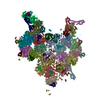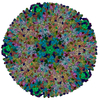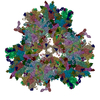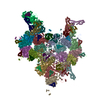[English] 日本語
 Yorodumi
Yorodumi- PDB-6nhj: Atomic structures and deletion mutant reveal different capsid-bin... -
+ Open data
Open data
- Basic information
Basic information
| Entry | Database: PDB / ID: 6nhj | ||||||||||||||||||
|---|---|---|---|---|---|---|---|---|---|---|---|---|---|---|---|---|---|---|---|
| Title | Atomic structures and deletion mutant reveal different capsid-binding patterns and functional significance of tegument protein pp150 in murine and human cytomegaloviruses with implications for therapeutic development | ||||||||||||||||||
 Components Components |
| ||||||||||||||||||
 Keywords Keywords | VIRUS / cryoEM / beta-herpesvirus / murine cytomegalovirus / human cytomegalovirus / pp150 / pUL32 / pM32 / bacterial artificial chromosome-based mutagenesis | ||||||||||||||||||
| Function / homology |  Function and homology information Function and homology informationT=16 icosahedral viral capsid / viral tegument / viral capsid assembly / viral process / viral capsid / host cell nucleus / structural molecule activity / DNA binding Similarity search - Function | ||||||||||||||||||
| Biological species |  Murine cytomegalovirus (Murine cytomegalovirus) Murine cytomegalovirus (Murine cytomegalovirus) | ||||||||||||||||||
| Method | ELECTRON MICROSCOPY / single particle reconstruction / cryo EM / Resolution: 5 Å | ||||||||||||||||||
 Authors Authors | Liu, W. / Dai, X.H. / Jih, J. / Chan, K. / Trang, P. / Yu, X.K. / Balogun, R. / Mei, Y. / Liu, F.Y. / Zhou, Z.H. | ||||||||||||||||||
| Funding support |  United States, 5items United States, 5items
| ||||||||||||||||||
 Citation Citation |  Journal: PLoS Pathog / Year: 2019 Journal: PLoS Pathog / Year: 2019Title: Atomic structures and deletion mutant reveal different capsid-binding patterns and functional significance of tegument protein pp150 in murine and human cytomegaloviruses with implications for ...Title: Atomic structures and deletion mutant reveal different capsid-binding patterns and functional significance of tegument protein pp150 in murine and human cytomegaloviruses with implications for therapeutic development. Authors: Wei Liu / Xinghong Dai / Jonathan Jih / Karen Chan / Phong Trang / Xuekui Yu / Rilwan Balogun / Ye Mei / Fenyong Liu / Z Hong Zhou /   Abstract: Cytomegalovirus (CMV) infection causes birth defects and life-threatening complications in immunosuppressed patients. Lack of vaccine and need for more effective drugs have driven widespread ongoing ...Cytomegalovirus (CMV) infection causes birth defects and life-threatening complications in immunosuppressed patients. Lack of vaccine and need for more effective drugs have driven widespread ongoing therapeutic development efforts against human CMV (HCMV), mostly using murine CMV (MCMV) as the model system for preclinical animal tests. The recent publication (Yu et al., 2017, DOI: 10.1126/science.aam6892) of an atomic model for HCMV capsid with associated tegument protein pp150 has infused impetus for rational design of novel vaccines and drugs, but the absence of high-resolution structural data on MCMV remains a significant knowledge gap in such development efforts. Here, by cryoEM with sub-particle reconstruction method, we have obtained the first atomic structure of MCMV capsid with associated pp150. Surprisingly, the capsid-binding patterns of pp150 differ between HCMV and MCMV despite their highly similar capsid structures. In MCMV, pp150 is absent on triplex Tc and exists as a "Λ"-shaped dimer on other triplexes, leading to only 260 groups of two pp150 subunits per capsid in contrast to 320 groups of three pp150 subunits each in a "Δ"-shaped fortifying configuration. Many more amino acids contribute to pp150-pp150 interactions in MCMV than in HCMV, making MCMV pp150 dimer inflexible thus incompatible to instigate triplex Tc-binding as observed in HCMV. While pp150 is essential in HCMV, our pp150-deletion mutant of MCMV remained viable though with attenuated infectivity and exhibiting defects in retaining viral genome. These results thus invalidate targeting pp150, but lend support to targeting capsid proteins, when using MCMV as a model for HCMV pathogenesis and therapeutic studies. | ||||||||||||||||||
| History |
|
- Structure visualization
Structure visualization
| Movie |
 Movie viewer Movie viewer |
|---|---|
| Structure viewer | Molecule:  Molmil Molmil Jmol/JSmol Jmol/JSmol |
- Downloads & links
Downloads & links
- Download
Download
| PDBx/mmCIF format |  6nhj.cif.gz 6nhj.cif.gz | 4.6 MB | Display |  PDBx/mmCIF format PDBx/mmCIF format |
|---|---|---|---|---|
| PDB format |  pdb6nhj.ent.gz pdb6nhj.ent.gz | Display |  PDB format PDB format | |
| PDBx/mmJSON format |  6nhj.json.gz 6nhj.json.gz | Tree view |  PDBx/mmJSON format PDBx/mmJSON format | |
| Others |  Other downloads Other downloads |
-Validation report
| Summary document |  6nhj_validation.pdf.gz 6nhj_validation.pdf.gz | 1.6 MB | Display |  wwPDB validaton report wwPDB validaton report |
|---|---|---|---|---|
| Full document |  6nhj_full_validation.pdf.gz 6nhj_full_validation.pdf.gz | 1.6 MB | Display | |
| Data in XML |  6nhj_validation.xml.gz 6nhj_validation.xml.gz | 594.3 KB | Display | |
| Data in CIF |  6nhj_validation.cif.gz 6nhj_validation.cif.gz | 946.3 KB | Display | |
| Arichive directory |  https://data.pdbj.org/pub/pdb/validation_reports/nh/6nhj https://data.pdbj.org/pub/pdb/validation_reports/nh/6nhj ftp://data.pdbj.org/pub/pdb/validation_reports/nh/6nhj ftp://data.pdbj.org/pub/pdb/validation_reports/nh/6nhj | HTTPS FTP |
-Related structure data
| Related structure data |  9366MC  9367C  9368C  9369C C: citing same article ( M: map data used to model this data |
|---|---|
| Similar structure data | Similarity search - Function & homology  F&H Search F&H Search |
- Links
Links
- Assembly
Assembly
| Deposited unit | 
|
|---|---|
| 1 | x 60
|
| 2 |
|
| 3 | x 5
|
| 4 | x 6
|
| 5 | 
|
| Symmetry | Point symmetry: (Schoenflies symbol: I (icosahedral)) |
- Components
Components
| #1: Protein | Mass: 151673.031 Da / Num. of mol.: 16 / Source method: isolated from a natural source / Source: (natural)  Murine cytomegalovirus (strain Smith) / Strain: Smith / References: UniProt: A0A1S5YGR4 Murine cytomegalovirus (strain Smith) / Strain: Smith / References: UniProt: A0A1S5YGR4#2: Protein | Mass: 78749.961 Da / Num. of mol.: 8 / Source method: isolated from a natural source / Source: (natural)  Murine cytomegalovirus (strain Smith) / Strain: Smith / References: UniProt: D3XDM2 Murine cytomegalovirus (strain Smith) / Strain: Smith / References: UniProt: D3XDM2#3: Protein | Mass: 9845.198 Da / Num. of mol.: 16 / Source method: isolated from a natural source / Source: (natural)  Murine cytomegalovirus (strain Smith) / Strain: Smith / References: UniProt: D3XDN6 Murine cytomegalovirus (strain Smith) / Strain: Smith / References: UniProt: D3XDN6#4: Protein | Mass: 33281.289 Da / Num. of mol.: 5 / Source method: isolated from a natural source / Source: (natural)  Murine cytomegalovirus (strain Smith) / Strain: Smith / References: UniProt: D3XDN4 Murine cytomegalovirus (strain Smith) / Strain: Smith / References: UniProt: D3XDN4#5: Protein | Mass: 34660.262 Da / Num. of mol.: 10 / Source method: isolated from a natural source / Source: (natural)  Murine cytomegalovirus (strain Smith) / Strain: Smith / References: UniProt: D3XDR2 Murine cytomegalovirus (strain Smith) / Strain: Smith / References: UniProt: D3XDR2Has protein modification | Y | |
|---|
-Experimental details
-Experiment
| Experiment | Method: ELECTRON MICROSCOPY |
|---|---|
| EM experiment | Aggregation state: PARTICLE / 3D reconstruction method: single particle reconstruction |
- Sample preparation
Sample preparation
| Component | Name: Murid herpesvirus 1 (strain Smith) / Type: VIRUS / Entity ID: all / Source: NATURAL |
|---|---|
| Molecular weight | Experimental value: NO |
| Source (natural) | Organism:  Murid herpesvirus 1 (strain Smith) Murid herpesvirus 1 (strain Smith) |
| Details of virus | Empty: NO / Enveloped: YES / Isolate: STRAIN / Type: VIRION |
| Buffer solution | pH: 7.4 / Details: PBS buffer, PH=7.4 |
| Specimen | Embedding applied: NO / Shadowing applied: NO / Staining applied: NO / Vitrification applied: YES |
| Specimen support | Grid material: COPPER / Grid mesh size: 200 divisions/in. |
| Vitrification | Instrument: HOMEMADE PLUNGER / Cryogen name: ETHANE / Details: The grids were manually plunged into the Ethane. |
- Electron microscopy imaging
Electron microscopy imaging
| Experimental equipment |  Model: Titan Krios / Image courtesy: FEI Company |
|---|---|
| Microscopy | Model: FEI TITAN KRIOS |
| Electron gun | Electron source:  FIELD EMISSION GUN / Accelerating voltage: 300 kV / Illumination mode: FLOOD BEAM FIELD EMISSION GUN / Accelerating voltage: 300 kV / Illumination mode: FLOOD BEAM |
| Electron lens | Mode: BRIGHT FIELD / Nominal magnification: 47000 X / Nominal defocus max: 3000 nm / Nominal defocus min: 1000 nm / Calibrated defocus min: 1000 nm / Calibrated defocus max: 3000 nm / Cs: 2.7 mm / Alignment procedure: COMA FREE |
| Specimen holder | Cryogen: NITROGEN / Specimen holder model: FEI TITAN KRIOS AUTOGRID HOLDER |
| Image recording | Electron dose: 25 e/Å2 / Film or detector model: AGFA SCIENTA FILM / Num. of real images: 2200 |
| Image scans | Scanner model: NIKON SUPER COOLSCAN 9000 |
- Processing
Processing
| EM software |
| ||||||||||||
|---|---|---|---|---|---|---|---|---|---|---|---|---|---|
| CTF correction | Type: PHASE FLIPPING AND AMPLITUDE CORRECTION | ||||||||||||
| Particle selection | Num. of particles selected: 58254 | ||||||||||||
| Symmetry | Point symmetry: I (icosahedral) | ||||||||||||
| 3D reconstruction | Resolution: 5 Å / Resolution method: FSC 0.143 CUT-OFF / Num. of particles: 47982 / Symmetry type: POINT | ||||||||||||
| Atomic model building | B value: 200 / Protocol: OTHER / Space: REAL |
 Movie
Movie Controller
Controller


 PDBj
PDBj
